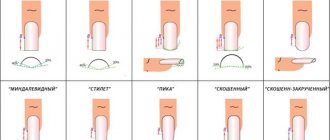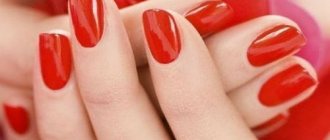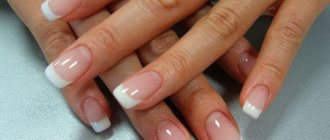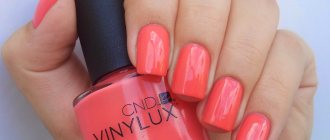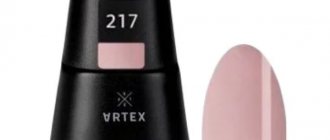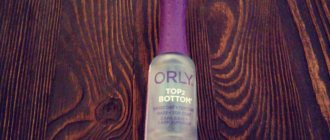and why don't I use it at work?
Natalia went to a beauty salon in the center of Voronezh for three years, where her nails were covered with Shellac. The coating lasted 7 - 10 days, and then began to chip and peel off. Natalya got used to this, and thought that this was how it should be. One day she urgently needed to update the covering, but there was no free window in the salon. On the same day she made an appointment with me for a manicure. I covered Natalya’s nails with gel polish, and we said goodbye.
Three weeks later, Natalya came to me again to update the coverage. She was very surprised that the coating lasted more than two weeks without chipping or peeling. I explained to Natalya that shellac was not suitable for her because she had a thin nail plate. She also explained the differences between gel polish, regular nail polish and shellac.
Differences between shellac, gel polish, gel and regular polish

Shellac (in common parlance Shellac) is a registered brand of CND. It is wrong to call all the varnishes we use to paint our nails Shellac.
- Gel polish and shellac are not the same thing. Shellac is a hybrid of regular nail polish and a special gel. These are Soak Off class gels (easy to remove), which are removed with a special liquid and do not require filing when removing.
The CND company tries not to compare its product with gel polish. Shellac CND is positioned as an absolutely unique composition for decorative manicure. In colloquial speech, shellac and gel polish are used as full synonyms.
There is a misconception that shellac differs from gel polish by the presence of an organic polymer with the same name “shellac”. At the same time, neither on the official website of the CND company, nor in the Shellac composition indicated on the packaging, there is any mention of the use of shellac resin or its derivatives. The word Shellac also appears in the names of gel polishes from brands such as Shellac Bluesky and AllShellac Premier. However, the organic polymer shellac is not included in any of the listed products.
- Gel polish and gel are gels of the same class, only different in degree of viscosity. The gel has a medium viscosity, so it can be used to extend nails or correct their shape. Classic gel polish (for example, shellac) has a low viscosity, so they are liquid. I cover my nails with 100% gel.
- Comparing regular varnish and shellac is not entirely correct. Nail polish - air-dries, Shellac cures (dries) under ultraviolet light.
- Shellac and gel differ in the way they are removed from nails. Shellac can be removed using special... liquids, gel - by filing. The gel can be worn for as long as desired while correcting the nails; shellac (gel polish) must be removed and the coating renewed. You can increase the length of your nails with gel, but this cannot be done with gel polish (shellac) - it is just a coating of the nails that is worn for 2 weeks and can be removed quite easily.
Features and recommendations for applying gel polish on extended nails

The procedure and technique for applying gel coating to artificial nails is not much different from the standard procedure, but there are some nuances that need to be taken into account.
Just like when covering natural nails with gel polish, you need to first shake the bottle with the product so that the pigment is mixed.
To make the manicure aesthetically pleasing, gel polish should be applied to extended nails in as thin a layer as possible. The fact is that a gel nail is much thicker than a natural one, and 2-3 dense layers of gel polish are unlikely to add grace and aesthetics.
Why don't I cover my clients' nails with Shellac?
Chips and detachments.
If you have healthy, strong, ideally shaped nails, then using the shellac system your coating will last a maximum of 14 days. Do you have weak, thin or peeling nails? The coating will not stick. Shellac will begin to chip and peel off within 7-10 days - depending on your luck. Everything is exactly this way due to the composition of the varnish itself and the base. SND Shellac base is liquid and acidic. The base is liquid when applied and very firm, but brittle when dry. It is not plastic, so thin, brittle and peeling nails will have chips and detachments.
To better understand, imagine two types of material - paper and board. Paper means thin nails, board means healthy ones. A liquid base was applied to both materials, which dried and hardened. Where will chips appear most quickly? On paper, because the solid material will begin to crack under a fragile base. The same thing happens with Shellac on thin and brittle nails.
Acid base
SND Shellack base is acidic. This means that the base contains components that, when applied, lift the scales of the top layer of the nail plate. Due to this, the base adheres tightly to the nail. No matter what they say, I think it’s harmful, especially for thin and weakened nails. The acid base dries the nail plate. This can cause nails to begin to peel and crumble, especially if the nails were not very strong and healthy to begin with.
Removing the coating by soaking.
According to the technology developed by CND employees, the coating must be removed by soaking. For removal, use special nail pads and removing liquid. The main active component of the remover is acetone, but it is called differently so as not to scare clients and professionals. I have already written about the dangers of this method of removing the coating. But here it won’t work any other way.
Shellac cannot be removed with a machine. Due to the peculiarities of the composition, the material is simply wound onto the cutter. The cutter gets stuck and clogs in the material. In addition, removing shellac with a machine is dangerous - the coating is so thin that there is a risk of sawing through the nail plate. Especially if the master is still unsure of holding the device in his hands. It is often difficult to determine exactly when to remove the foil because different nails may have different base thicknesses. If you haven’t kept your nails in foil enough, then you’ll have to use a pusher and an orange stick to remove the remaining base from the nail. This leads to delamination. If you overexpose your nails under foil, this leads to drying out of the nail plate.
You've probably noticed that after regularly wearing gel polish, your nails weaken, peel, sometimes curl, and white spots and grooves appear. Usually everyone blames gel polish - they say it's harmful, but it's not. This is an acetone containing liquid. It dries out the nail plate, and you can end up with brittle, brittle and peeling nails.
Coated nail repair
Standard situation: got a coated manicure. Three days later, while digging through my purse to find my phone, one of my nails accidentally cracked. There is no point in redoing all your nails - you only need to fix the cracked one. If your nails are covered with shellac, then you will not be able to repair the nail.
Here's what CND representatives advise you to do in such a situation: It all depends on the condition of the nails, but still, such nails are best repaired with acrylic or gel. It's more reliable. It is important to understand that CND Shellac is designed to strengthen well-shaped natural nails. Acrylic and gel cope perfectly with all problems (flat nails, springboard-shaped, broken, etc.).
If a nail covered with Shellac is cracked, it cannot be “fixed” - all ten fingers will have to be redone.
No alignment of the nail plate.
Everyone loves beautiful nails with perfect highlights. Highlights are obtained when the nail has an ideal shape. But the nail does not always have the correct architecture. There are flat, trapezoidal, with tubercles and irregularities, and as many as you like.
To hide these irregularities and give your nails an ideal shape, leveling the nail plate comes to the rescue.
Here are two photos - on some nails the nail plate was aligned, but on others not.

Can you guess which nails are covered with shellac?
The nail plate is leveled with a thick base so that it hides all the irregularities and flaws in the natural shape of the nail. The shellac base is liquid, it spreads over the nail in a thin layer and follows all its irregularities. In shellac, the base serves only to adhere the material to the nail. For full-fledged gel polishes, the base, in addition to adhesion, also forms the correct shape of the nail.
Often counterfeited
Original products are expensive, due to the fact that they are produced and delivered from the USA. That's why Shellac is being counterfeited. Counterfeits are stamped in China, where they are much cheaper. There is no problem buying original products on the official website, or from official representatives, the only problem is the price. Some beauty salon owners buy fake Shellac on Aliexpress. If you paint your nails with this substance, you can easily get a chemical burn or an allergic reaction.
Thickens quickly.
Shellac thickens in open air. This drawback causes more inconvenience for craftsmen than for clients. The master paints the client’s nails, and the varnish in the bottle slowly thickens. The material thickens under the influence of UV rays in a special lamp. When the master opens the bottle, the material is exposed to sunlight, which carries those same UV rays. It often happens that, having used only half the volume of shellac, it becomes impossible to use it further. The material thickened and became unsuitable for work.
These were the shortcomings of shellac, but it deserved worldwide popularity and fame for a reason.
Differences
Despite such an impressive number of similarities, biogel and shellac also have significant differences:
- Biogel is used both for nail extensions and for applying designs. Shellac is used only as a decorative coating;
- The biogel is based on protein, so it not only covers the horny plate with a durable protective layer, but also strengthens it from the inside. Shellac only protects from external influences; it will not solve the problem of thin and flaky nails;
- Shellac is applied in a thinner layer, but at the same time it is harder and not very elastic, which is why it does not tolerate deforming loads well. Biogel is more flexible, so it can easily cope with everyday loads and requires virtually no special care;
- You can do nails with shellac yourself; the procedure for applying biogel is much more difficult, so it is better to go to a qualified nail salon;
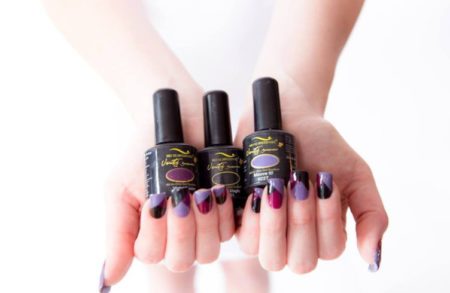
- Biogel is easily destroyed upon contact with household chemicals, alcohols and acetone. Even dishwashing or floor detergent can dissolve it. Therefore, all housework (washing, cleaning) must be done with rubber gloves in order to protect the coating from premature destruction. Shellac is resistant to various chemical influences and does not require special care;
- Biogel can either imitate the natural color of the nail or be any other color. Shellac has from 10 to 24 shades, which also gives a lot of room for imagination;
- When working with biogel, you can change the length and shape of the nail. You can also apply a design on top of it. Shellac does not provide such opportunities;
- Shellac is not recommended to be applied to thin and brittle horn plates, as it can aggravate the problems. Biogel, in contrast, has a healing effect; it strengthens weak and damaged nails;
- The procedure for removing the protective film from nails also differs. Shellac is removed quickly and easily. You can do this procedure at home, but it is better in the salon. The coating can be easily removed with acetone or alcohol. Biogel can only be removed using a special solution that does not damage the nail. To carry out this procedure, you will definitely have to contact a specialist.
Why is shellac so popular?
If we talk about Voronezh, shellac is mainly used by beauty salons and nail bars. It is convenient for salons to use this material. Covering time is 30 – 40 minutes. One master in the salon can serve 8–10 clients per day. In nai bars the client norm is even higher, 20 – 30 clients per day.
If you remember that shellac is usually worn for 7-10 days, then it turns out to be a very profitable conveyor belt for salons and nail bars. Today the salon let the client go, and a week later he goes back to the salon to renew his coating. It is not profitable for salons for their specialists to spend 2-2.5 hours working with each client, and for the coating to last at least two weeks. If you do this, the flow of customers will decrease significantly. One master can serve, at best, three clients a day. Clients will go for correction once every two or three weeks.
Salons work on those products that are primarily beneficial to them. They will not tell you that shellac is not suitable for you because you have thin, weakened nails. You will be given a coating, and since you have thin nails, you will be offered additional care products. Naturally for additional money.
Types of biogel
Today, several types of biogel are used; they differ not only in color palette, but also in application:
- Sculptural biogel - can be used as a firming and leveling agent. It gives elastic texture and natural shade. It can be used if you need to do a small nail extension; it is also used in nail art and when creating an aquarium design.
- Biogel for fixing manicure. It is used before applying a layer of decorative coating. It comes in cool tones, which helps hide the natural yellowness of the nail.
- Colored biogel. It can be used as an independent coating, since after drying it acquires strength and flexibility at the same time.
Advantages of Shellac
cool color palette.
High-class designers work on the colors. Many colors and shades of other brands of gel polishes were copied from shellac. Even now, there are several colors that none of the manufacturers of other brands have been able to copy. CND can be proud of its color palette. The Shellac product line has good cuticle and hand skin care products. This is a really good product that really works. The main action is aimed at restoring the cuticle and nail plate. This is not surprising if you remember that shellac is removed only by soaking. It is the nails and cuticles that suffer from this.
Coating time.
To make a full manicure with shellac coating, the master only needs 30-40 minutes. It's very fast. For comparison, a hardware manicure with gel polish takes 2 – 2.5 hours. You just need to understand that the quality of the coatings will also vary. If you are not particularly interested in nail services, and have only heard about shellac, then this is what you will cover your nails with. Especially if you prefer to get your nails done in a beauty salon. Hence the popularity of this coating, despite all its shortcomings.
What you need for a shellac manicure at home
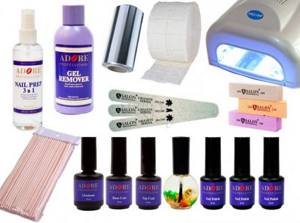
By choosing a shellac coating, a fashionista gets a two-week manicure in one hour that does not lose its gloss, does not chip or crack. But such a result is only possible if you know all the subtleties of application. Otherwise, the end of the wear will come in just a few days.
To make your hands beautiful you need to stock up on time, patience and the necessary materials:
- File with abrasiveness 230 grit
- File for natural nails
- Polishing buff
- Degreaser
- Lint-free wipes
- Cuticle remover
- Pusher or orange stick
- Primer
- Bonder
- Base coat
- Pigmented gel polish
- Finish coating
- Dispersion remover
- Cuticle oil
- UV or LED lamp
To ensure that your manicure at home does not disappoint, you need to pay attention to the base and top coat. It is best to choose proven, well-known companies, since in pursuit of profit you may come across low-quality material. The consequences of such savings can be not only in a short-lived manicure, but also in harm to shellac nails. The finish and base should be of a uniform consistency, without lumps or foreign substances. When purchasing, be sure to check the expiration date of the material.
Experienced experts recommend not wearing shellac for more than two weeks and taking a break after the second reapplication for a week, or better yet, two.
This is necessary for the nail plate to rest and recover. During this period, it is better to treat it with various strengthening agents at home.
Pros and cons of shellac
Of the minuses:
- Shellac is only suitable for strong and healthy nails.
- The maximum time without chips and detachments is 14 days. More often 7 – 10 days.
- The material will not adhere to thin and weakened nails.
- Shellac can only be removed by soaking. This dries out the nail plate.
- Cannot be used to repair a cracked nail
- A shellac base will not give your nails an ideal shape.
- Shellac is often counterfeited, so there is a risk of allergies or chemical burns.
Pros:
- Chic color palette
- Quick to apply
In 2010, when CND released Shellac, it took the nail industry by storm. After regular polishes that stayed on nails for 2-3 days, Shellac could be compared to man’s first flight into space, or the release of the first iPhone. I covered my nails with it three or four times. For that money, I paid twice as much as a regular coating, but after a week it was embarrassing to walk around with such nails. I was not happy with the coating. Now my opinion about the material has not changed. Shellac itself has also remained the same since 2010, but additional product lines are released every year.
In my opinion, shellac has more disadvantages than advantages. That's why I don't use it at work. What do you think?
For dessert, a video about a machine that paints your nails itself.
So soon a manicurist will no longer be needed


